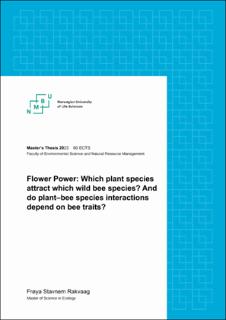| dc.description.abstract | Insects constitute the world’s most diverse class of animals and are vital for ecosystem function, services, and human welfare. Bees are considered some of the world’s most important pollinators, and declining bee richness and abundance could have devastating effects on agricultural productivity and ecosystem stability. Habitat destruction has led to declines in food resources for bees in agricultural areas, entailing serious negative impacts on pollinator communities. To help mitigate this loss, increasing flower resource availability is essential, for example by sowing flower strips. The establishment of flower strips is an environmental scheme used throughout Europe, to increase the food resources available for pollinating insects in agricultural areas and prevent the decline in richness and abundance of pollinators. Nevertheless, the knowledge of how plant species composition affects bee diversity is limited.
This thesis aims to assess how different plant species contribute to wild bee richness and to bee diversity within distinct trait groups i.e., sociality: social vs solitary, diet preference: specialist vs generalist, or taxonomic family. Thirty-two locations in Southeast Norway were sampled. Resource-seeking bees within the transects were collected using netting. In one-half of the locations, bees were sampled along transects with a sown flower strip on one side and roadside vegetation on the other. In the second half of the locations, bees were sampled along transects with a grain field on one side and roadside vegetation on the other. To assess plant species composition and abundance at different sites, vegetation squares were used to conduct a vegetation analysis.
This study found that there was a great variance in which plant species bees were attracted to. Several key plant species stood out as popular plant species, contributing to both bee abundance and diversity. Additionally, bee traits, i.e., sociality, diet niche and taxonomic family, influenced the plant–bee interactions (attraction). Moreover, flower strips differed from the roadside in both abundance and species composition.
This study provides insight into the network of interactions between wild bee species and plant species, and the plant preferences of bees based on some traits. This knowledge could improve the effect of flower strips as an environmental scheme, potentially improving the quality of flower strips to support a larger variety of bee species | |
